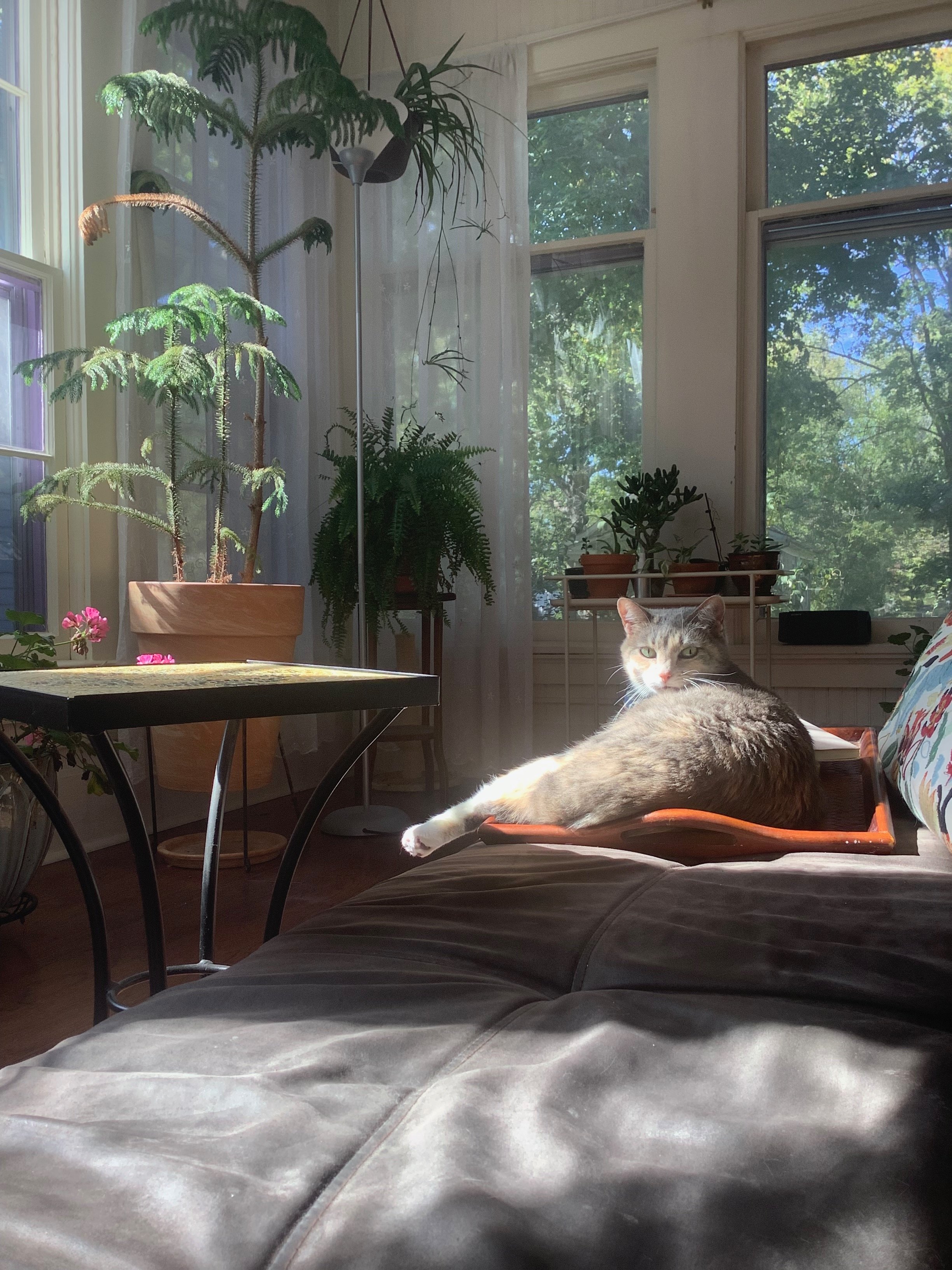Megan Kaminski
The sunporch in my home where I read and write with plant friends and Brenda the cat.
Readings
A (couple of) book(s) of poetry from the past year
Sasha taqwšəblu LaPointe, Rose Quartz (Milkweed, 2023)
Once I started this gorgeous book, I couldn’t put it down. An evocative swirling of story and incantation that feels like a recovery of self, family, and place. There’s such an urgency to these poems—a way in which the act of reading them is to be drawn into their portal of transformation: “I will lose my name in the billowing smoke/ will sing a circle inside salt lines.” LaPointe’s fierce and gentle vulnerability in the face of personal and collective trauma shines love into places of great pain. I felt the magic of these poems working in my breath as I read along, and deep in my bones as they invited me in.
Erín Moure, Theophylline, (House of Anansi, 2023)
It’s such a delight to spend time in the company of Moure’s big-hearted intelligence. Erín Moure was one of the first contemporary poets whose writing I fell in love with, and I’ve been reading her books of poetry and translation ever since. She’s in fine form here, in this interweaving of essay and poem, embodied utterance and memory. Moure works expansively through the archives of three modernist women poets—Rukeyser, Bishop, and Grimké—in the mode of a translator connecting across time to shared experiences of migration, queerness, breath, and outsider-ness. I love the way the poems take on the breath of each poet and the way Moure imagines with them.
A poet from your hometown or current (or past) location and how knowing the location affects your reading
Ariana Benson, Black Pastoral, (University of Georgia Press, 2023)
Ariana Benson’s beautiful and haunting debut is set in the coastal wetlands of the seven cities of Hampton Roads in Southern Virginia. It’s been about twenty years since I’ve called Virginia Beach home, and, while I didn’t think of myself as a poet when I was growing up there, the landscape of the place and the shadows of its histories are certainly imprinted deep in my memory and body. Here Benson brings silenced histories and the thickness of place into dazzling form, complicating the romantic tradition of the pastoral into something more vital, vibrant, and multivalent. There’s such powerful beauty in the rendering, excavation, and re-imagining of these places and stories, as the Dismal Swamp speaks to Moses Grandy in poem early in the collection: “I hope/ you knew I heard the song of your silence, your heartbeat/ camouflaged in the thrumming pulse of mine.”
A poem or book you like to teach
Camille Dungy, “Characteristics of Life,” (Poets.org, 2012)
This is one of my absolute favorite poems and favorites to teach. I love the way Dungy pushes metaphoric thinking and plays with our contemporary reservation around anthropomorphism when encountering other species. The poem demonstrates the ways the extractive and exploitative values that permeate our culture limit our ability to truly see more-than-human persons and ourselves for who we are and could be.
Writings
Currency
In those gray days I became one that heard
music in closets, in office bureau drawers. Songs
lilted into tired lecture into the most routine
shipping directions and explanations of production
requirements. I traced counter-harmonies in veins
bulging from my boss’ forehead when she laughed
her horsey laugh. Understand that I was neither
musician nor audience, just a person in way of its
passing from muse to siren, from source to bottling
plant, a scout for futures gone astray. When my
insides shifted restless, the outside world made way.
Invitation
Cat cries ghost morning, warm bone
through vibration through welcome
sparking electric into fingers. Robins join,
guiding the world to light, tulips crown
through soil; spring comes a little early.
Visits from cardinal lovers and groundhogs
nibbling clover before sheltering under porch.
Each day a palm outstretched grasping
to hold what we cannot. Give me a chance
and I’ll meet you tender, save a seat for
the parts of you stratifying in cold soil,
wanting for their own place in the sun.
Home
A house with spiders in every corner:
one behind the salt lamp, ceiling
spider above the suspended pothos in
the sunroom, jumping ones on
the tub base—spiders love hot
baths—even brown recluses in
the stone-lined basement. I heard
it’s bad luck to kill them and so
beyond our daily knowledge
ghosting unseen in such close
proximity, I let them be. Imagine them
architecting moon colonies in my own dreams
at night and even my cat pokes
only with soft paws, claws retracted.
Eight-legged promises of lives beyond
anything we can fathom as we pad
warm-fleshed through winter rooms,
touching briefly never to hold.
Megan Kaminski is the author of three books of poetry, most recently Gentlewomen (Noemi Press, 2020), as well as Prairie Divination (Sunseen Books, 2022), an oracle deck and book of essays in collaboration with artist L. Ann Wheeler, and Quietly Between (A Viewing Space, 2022), a co-authored collection of poetry and photography. A Professor in the English Department’s Creative Writing Program and in the Environmental Studies Program with a courtesy appointment in Visual Art at the University of Kansas, she specializes in poetry, the plant humanities, and eco-arts and writing practices. Megan was recommended to Etcetera by Philip Matthews.
